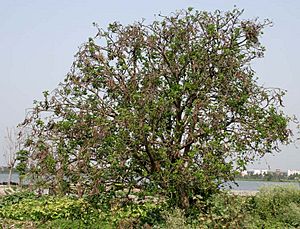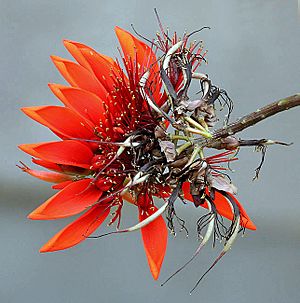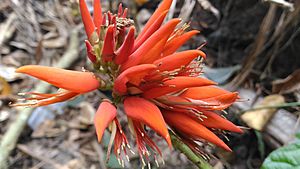Tiger's claw facts for kids
Quick facts for kids Tiger's claw |
|
|---|---|
 |
|
| A Tiger's Claw tree in Kolkata, West Bengal, India. | |
| Conservation status | |
| Scientific classification |
The Tiger's Claw tree, also known as the Indian Coral Tree, is a beautiful plant found in warm, tropical places. Its scientific name is Erythrina variegata. This tree grows naturally in eastern Africa, across the Indian subcontinent, northern Australia, and on many islands in the Indian Ocean and western Pacific Ocean, all the way to Fiji.
Contents
The Amazing Tiger's Claw Tree
What Does It Look Like?
The Tiger's Claw tree is a deciduous tree. This means it loses its leaves every year, usually during the dry season. It can grow very tall, sometimes up to 27 meters (about 88 feet). The tree has thorns on its trunk and branches.
Its leaves are special. They are called "pinnate" leaves, which means they have smaller leaflets arranged along a central stem. Each leaf has three leaflets, and each one can be up to 20 centimeters (about 8 inches) long and wide. When the tree blooms, it has many bright scarlet or crimson flowers grouped together. After the flowers, it produces black seeds.
How People Use This Tree
The Tiger's Claw tree is very popular as an ornamental tree. This means people plant it because it looks pretty, especially with its colorful flowers. There are even different types of this tree, called "cultivars," like 'Alba', which has white flowers instead of red ones.
Food and Farming
In some places, like Vietnam, people use the leaves of the Tiger's Claw tree to wrap fermented meat. This is a traditional way to prepare food.
Farmers also find this tree useful in "agroforestry systems." This is a way of farming where trees are grown among crops or livestock. The leaves of the Tiger's Claw tree are good for feeding animals because they have many nutrients.
The seeds of the tree are poisonous if eaten raw. However, they can be cooked and then eaten safely. In the past, people also used the seeds and bark to stun fish in the water. This made it easier to catch them.
Crafting and Tools
The Puyuma people, an aboriginal tribe in Taiwan, use the trunk of the Tiger's Claw tree to make a special mortar. This tool is called a "ta?ur." They use it to pound sticky rice, which is then steamed to make a traditional dish.
Its Special Meaning to People
The Tiger's Claw tree has a special place in the culture of many regions. In 1967, its flower was chosen as the official flower of Okinawa Prefecture in Japan. This flower, called "deigo" in Okinawa, is even mentioned in a famous song called "Shima Uta" by the band The Boom. This song is very well-known in Okinawa. Also, the wood from the deigo tree is used to make unique Ryukyuan lacquerware, which is a special type of decorated art.
In Sri Lanka, the beautiful blossoming flowers of the Tiger's Claw tree are a sign of the upcoming Sri Lankan New Year, which happens in April. In the Sinhala language, the plant is called Erabadu (එරබදු). In Tamil, it is known as “Mulmurukai.”
See also
 In Spanish: Erythrina variegata para niños
In Spanish: Erythrina variegata para niños




